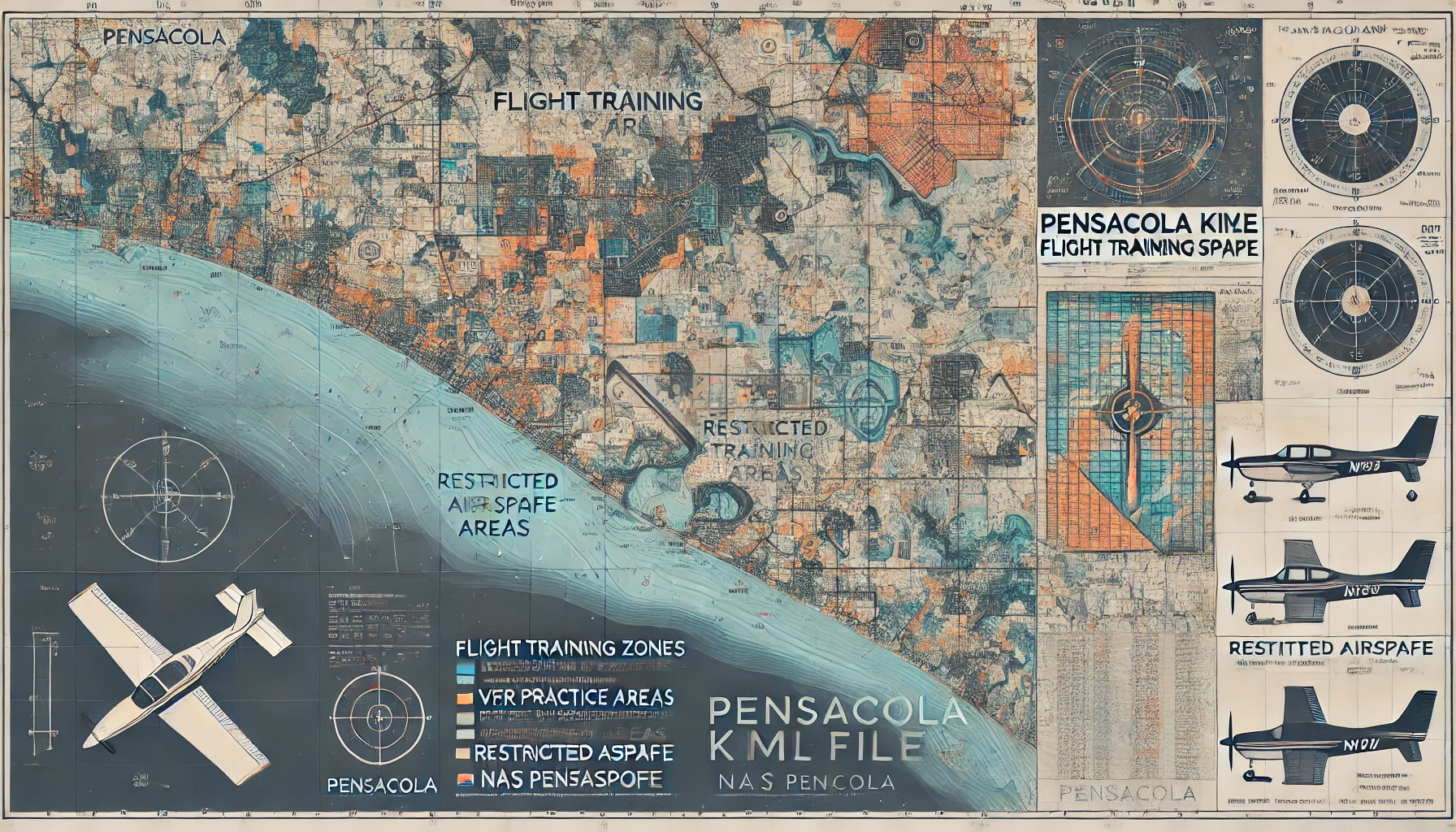Pensacola KML File Flight Training Areas Training with Precision and Safety
Pensacola, Florida, is renowned for its prominent role in aviation training, serving as a hub for both military and civilian pilots. With its expansive airspace and diverse training requirements, Pensacola offers a variety of flight training areas, specifically designed to support the needs of student pilots, instructors, and experienced aviators alike. One of the most effective tools for managing and visualizing these training areas is the Pensacola KML file flight training areas.
A Keyhole Markup Language (KML) file is a format used to represent geographic data, which can be imported into various mapping tools such as Google Earth, ForeFlight, and SkyVector. When applied to aviation, KML files help visualize the boundaries of flight training areas, restricted zones, and other key airspace features. In this article, we will explore the importance of Pensacola KML file flight areas, how they are used, and their significant impact on aviation safety and efficiency.
What Are Pensacola KML File Flight Training Areas?
Pensacola KML file flight training areas are geographic data files that outline specific zones used for flight training purposes within the Pensacola airspace. These areas are mapped out to ensure that flight training can be conducted safely and effectively, without conflicting with other air traffic.
A KML file contains detailed information about:
- The geographical boundaries of flight training zones
- Airspace restrictions, including military zones around NAS Pensacola
- Visual landmarks for navigation
- Flight paths and traffic corridors used during training exercises
These KML files are integrated with flight planning software and tools such as Google Earth, SkyVector, and ForeFlight. By using KML files, pilots can visualize training areas and navigate Pensacola’s airspace with greater precision.
The Role of KML Files in Aviation
KML files are pivotal in modern aviation training, especially in complex airspace regions like Pensacola. These files serve several critical functions:
1. Mapping Airspace Boundaries
KML files allow pilots to see the boundaries of training areas, including restricted zones around military bases like NAS Pensacola. This helps ensure that pilots do not accidentally enter areas where they are not authorized to fly.
2. Improving Situational Awareness
By visualizing the airspace in real-time, pilots and flight instructors can have a clearer understanding of their surroundings, helping them make better decisions during training sessions.
3. Efficient Planning
With the ability to plan routes and visualize airspace features in advance, flight schools can streamline their training programs, allowing for more focused and organized lessons.
4. Safety
KML files significantly enhance aviation safety by preventing pilots from inadvertently flying into congested or restricted airspace, thus minimizing the risk of mid-air conflicts and accidents.
Types of Flight Training Areas in Pensacola
Pensacola’s airspace is divided into several types of flight training areas, each serving a unique purpose. KML files help pilots and instructors navigate these areas with greater precision and clarity. The following are the main types of flight training areas in Pensacola:
1. VFR (Visual Flight Rules) Practice Areas
VFR practice areas are crucial for student pilots who are learning basic flight maneuvers, such as climbs, turns, and stalls. These areas are typically located outside of commercial flight paths and provide a controlled environment where students can practice without the risk of encountering other high-traffic aircraft.
Using KML files, pilots can:
- Identify the exact boundaries of VFR practice areas
- Plan their routes to avoid restricted or high-traffic zones
- Visualize landmarks and airspace features to assist in navigation
These VFR areas are essential for safe training, as they allow students to focus on honing their flight skills without worrying about airspace congestion or potential conflicts with other aircraft.
2. Controlled Airspace Zones
Pensacola’s airspace includes several controlled airspace zones where air traffic is managed by air traffic controllers. These zones are typically located near airports and military facilities like NAS Pensacola. Pilots must follow specific procedures when flying within these zones to maintain safety and ensure smooth coordination with air traffic control.
KML files help pilots:
- Identify controlled airspace boundaries
- Understand the rules and regulations for flying within these areas
- Avoid conflicts with other aircraft and air traffic controllers
By using KML files, pilots can easily navigate controlled airspace and ensure that their flight training remains within designated boundaries.
3. Restricted Military Airspace
Pensacola is home to NAS Pensacola, one of the most prominent military aviation hubs in the United States. As a result, a significant portion of the airspace around Pensacola is restricted for military use. These restricted areas are essential for military training and operations but can present challenges for civilian pilots if they are not carefully managed.
KML files play a critical role in:
- Identifying restricted military airspace
- Ensuring that civilian aircraft avoid restricted zones during flight training
- Allowing military and civilian air traffic to operate without interference
With KML files, pilots can avoid restricted airspace and ensure that they remain clear of military operations.
How to Obtain Pensacola KML File Flight Training Areas
Pilots can obtain KML files for Pensacola flight training areas from a variety of sources:
- FAA Digital Products: The Federal Aviation Administration (FAA) provides geographic data, including KML files for flight training areas in Pensacola. These files can be downloaded from the FAA website or other official sources.
- ForeFlight and SkyVector: Popular flight planning tools like ForeFlight and SkyVector allow pilots to import KML files and use them for real-time navigation and route planning.
- Google Earth: Pilots can upload KML files to Google Earth to visualize the airspace and training areas in a highly detailed and interactive environment.
Once the KML files are obtained, they can be imported into flight planning software to help visualize training zones, restricted areas, and key geographical landmarks.
Benefits of Using Pensacola KML File Flight Training Areas
The use of Pensacola KML file flight training areas offers several advantages for pilots, instructors, and flight schools:
1. Enhanced Navigation
By visualizing the boundaries of flight training areas, pilots can avoid flying into restricted zones or areas with high traffic, improving their ability to navigate Pensacola’s complex airspace.
2. Improved Safety
KML files significantly improve safety by providing a clear view of airspace boundaries, restricted zones, and other important features. Pilots can plan their routes more effectively, reducing the risk of mid-air conflicts and accidents.
3. Efficient Training Sessions
Flight schools can use KML files to streamline their training programs, ensuring that lessons are conducted within the designated training zones. This helps instructors focus on teaching rather than navigating ambiguous airspace boundaries.
4. Real-Time Updates
KML files can be updated regularly to reflect changes in airspace boundaries, military zones, and other important features. Pilots can download the latest files to ensure they have accurate information during flight training sessions.
Tools to Visualize Pensacola KML Files
Several flight planning and mapping tools are available for visualizing Pensacola KML file flight training areas:
1. Google Earth
Google Earth is a powerful tool for visualizing KML files. Pilots can upload the Pensacola KML files into Google Earth to view detailed maps of flight training areas, restricted zones, and landmarks.
2. ForeFlight
ForeFlight is an advanced flight planning app used by pilots for route planning, weather monitoring, and navigation. ForeFlight allows pilots to import KML files to visualize training areas and airspace boundaries in real time.
3. SkyVector
SkyVector is another popular tool for visualizing sectional charts, airspace maps, and flight routes. Pilots can use SkyVector to integrate KML files for better situational awareness during training.
Flight Schools in Pensacola Using KML Files
Many flight schools in Pensacola have adopted KML files to enhance their training programs. These schools include:
1. SkyWarrior Flight Training
SkyWarrior Flight Training offers a comprehensive flight training program for student pilots. The school uses KML files to ensure precise navigation during lessons, helping students avoid restricted zones and other hazards.
2. Pensacola Aviation Center
Pensacola Aviation Center integrates KML files into its training curriculum, providing students with real-time visual data of flight training areas, VFR zones, and restricted airspace. This helps students stay aware of their surroundings and navigate safely.
Challenges in Using Pensacola KML File Flight Training Areas
While KML files are a valuable tool for flight training, there are some challenges that pilots may face:
1. Airspace Congestion
Pensacola’s airspace is often busy with flight training activities. Pilots must be aware of airspace congestion and plan their routes accordingly to avoid collisions and ensure a smooth training experience.
2. Weather Conditions
The Gulf Coast region is prone to rapidly changing weather conditions, which can affect flight training. Pilots should integrate weather data with KML files to ensure safe navigation during unpredictable weather events.
Conclusion
Pensacola KML file flight training areas are an essential tool for pilots and flight schools, enabling precise navigation, enhancing safety, and streamlining training programs. By visualizing airspace boundaries, restricted zones, and VFR practice areas, KML files allow pilots to focus on their training without worrying about conflicting air traffic or restricted zones.
With the help of tools like Google Earth, ForeFlight, and SkyVector, pilots can easily import and utilize KML files for real-time flight planning. As Pensacola continues to be a major aviation hub, the use of KML files ensures that flight training remains safe, efficient, and organized, helping pilots of all levels improve their skills and knowledge.
Aa Gopura Kalasam Neevaithe Song A Cultural And Musical Treasure






